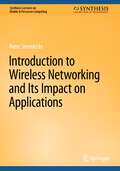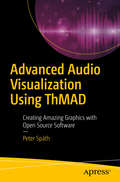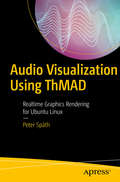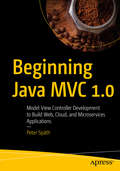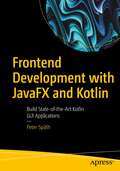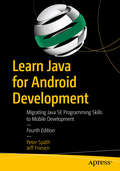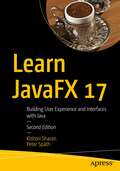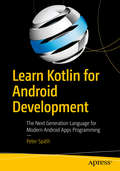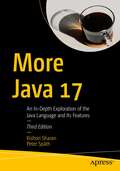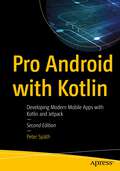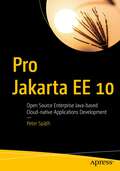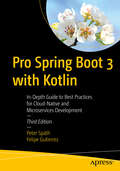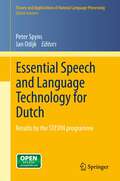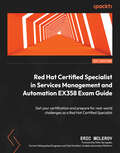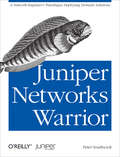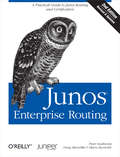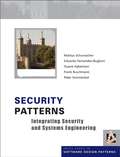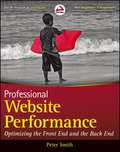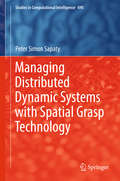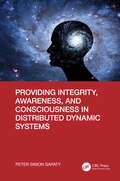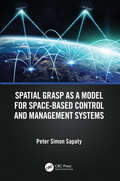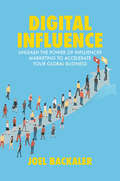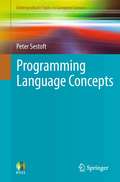- Table View
- List View
Investigating Computer-Related Crime
by Peter Stephenson Keith GilbertSince the last edition of this book was written more than a decade ago, cybercrime has evolved. Motives have not changed, but new means and opportunities have arisen with the advancement of the digital age. Investigating Computer-Related Crime: Second Edition incorporates the results of research and practice in a variety of venues, growth in the fi
Introduction to Wireless Networking and Its Impact on Applications (Synthesis Lectures on Mobile & Pervasive Computing)
by Peter SteenkisteThis book teaches readers how wireless networks work, why some of their properties impact wireless network performance at the application level, and what both network engineers and application developers can do to cope with these challenges. Internet users increasingly rely on wireless access links for diverse tasks such as web browsing, video conferencing, interactive games, and data sharing. Irrespective of how they access the Internet, they expect good performance and a high quality of experience. Unfortunately, wireless access networks are much more challenging to build than wired networks. In wired networks, signals used for communication are contained in a carefully engineered transmission medium. In contrast, wireless signals travel in our physical environment, where the presence of obstacles, interference, and mobility can affect communication. In addition, network performance can differ significantly across physical environments. As a result, the performance of wireless links is often lower and less predictable than that of wired links. The author structured the book according to the layers in the Internet protocol stack, similar to traditional network books. However, rather than presenting a general description of each layer, the focus is on wireless networks and how they differ from wired networks.
Advanced Audio Visualization Using ThMAD: Creating Amazing Graphics with Open Source Software
by Peter SpäthLearn advanced techniques and improve your audio visualization skills with Thinking Machine Audio Dreams (ThMAD). With this book, you can concentrate on advanced examples and usage patterns, including using shaders in a more profound way, and how to incorporate ThMAD into a tool chain using the professional sound server JACK.
Audio Visualization Using ThMAD
by Peter SpäthLearn how to use Thinking Machine Audio Dreams (ThMAD), a realtime audio visualization engine for Ubuntu Linux. This book bridges the gap between programmers and artists. Both artists and developers with an inclination towards arts will profit from this book since it is a combination of a hands-on tutorial, manual, and reference, with many illustrations that accompany the explanations and tutorials.You'll learn the basics of ThMAD's open source software suite and then start experimenting and building your own rendering pipelines to create audio visualizations. You'll see how to soundly use all ThMAD's GUI functionalities, and all modules are provided in a way that will serve both intellectual curiosity and professional needs. The examples that are used as part of the software, and the tutorials included in the book, will serve as a solid basis for your own experiments.What You'll LearnUse the ThMAD software, all GUI functionalities, and all modulesDevelop your own audio visualization projectsExplore the program operations for ThMAD Artiste and ThMAD Player, including all possible options for controlling program operations.Who This Book Is ForVisual artists with some IT background, or developers with artistic inclinations. Development experience is not required, but surely helpful.
Beginning Jakarta EE: Enterprise Edition for Java: From Novice to Professional
by Peter SpäthBuild Java-based enterprise applications using the open source Eclipse Jakarta EE platform. This feature-packed book teaches you enterprise Java development top to bottom. It covers Java web-tier development using servlets, JavaServer Faces (JSF), RESTful applications, and JSON. You’ll also cover Java data-tier development using persistence and transaction handling, messaging services, remote procedure calls, concurrency, and security to round out a complete Java-based enterprise application.Step by step and easy to follow, Beginning Jakarta EE includes many practical examples. Written by a Java expert and consultant, this book contains the best information possible on enterprise Java technologies. You’ll see that Jakarta EE is the next evolution of Java EE 8 and how it is one of the leading Java platforms for enterprise application development. What You Will LearnBuild enterprise Java applications using Jakarta EESet up your development environmentCreate page-flow web applications with JSF Write single-page web applications with REST and JSONPersist data using JPA in Jakarta EEBuild enterprise Java modules using EJBs and CDI Work with transaction engines using JTA Secure, log, and monitor your Jakarta EE applications Who This Book Is ForBeginning Java EE application developers with some experience of Java 8.
Beginning Java MVC 1.0: Model View Controller Development to Build Web, Cloud, and Microservices Applications
by Peter SpäthGet started with using the new Java MVC 1.0 framework for model, view, and controller development for building modern Java-based web, native, and microservices applications. Beginning Java MVC teaches you the basics, then dives in to models, views, controllers. Next, you learn data binding, events, application types, view engines, and more. You will be given practical examples along the way to reinforce what you have learned. Furthermore, you'll work with annotations, internationalization, security, and deployment. After reading this book, you'll have the know how to build your first full Java-based MVC application. What You Will Learn Discover the Java MVC 1.0 APIs and how to use them Master the Model, View and Controller design pattern Carry out data binding Write events Work with view engines Who This Book Is For Those new to Java MVC 1.0. Some prior experience with Java programming recommended, especially with JSF or Struts.
Frontend Development with JavaFX and Kotlin: Build State-of-the-Art Kotlin GUI Applications
by Peter SpäthBuild elegant, responsive, and stable Java Virtual Machine-based client applications (Fat Clients) with modern user interfaces. This book introduces JavaFX as a frontend technology and utilizes Kotlin instead of Java for coding program artifacts to boost code expressiveness and maintainability. Author Peter Späth employs a hands-on approach, providing practical examples and code to demonstrate each concept. Mid-level Java programming knowledge and a basic understanding of Kotlin are the only prerequisites; experience with JavaFX and frontend coding is not essential. JavaFX is a modern frontend programming toolkit equipped with containers, menus, buttons, sliders, text fields, and various other controls necessary for communicating with your users, all of which are covered here. Despite its name, JavaFX applications can be coded with programming languages other than Java. The central requirement is that any language targeting JavaFX compiles to artifacts runnable on a Java Virtual Machine. Over the course of this book, you’ll learn firsthand why Kotlin, with its elegant and concise syntax, is a perfect match. After completing Frontend Development With JavaFX and Kotlin, you will be able to build frontends of mid-to-high level complexity, depending on present Java skills, and use Kotlin as a language for addressing GUI programming needs and accessing the JavaFX API. What You Will Learn Create a JavaFX + Kotlin development pipeline for Gradle, Eclipse and IntelliJUse JavaFX scenes, stages, and nodes/controlsMaster JavaFX event handling, effects, and animation using KotlinUnderstand the JavaFX Concurrency Framework and Kotlin Coroutines for JavaFX Who This Book Is For Low- to mid-level Java or Kotlin developers with or without JavaFX experience who wish to learn how to build JavaFX applications with Kotlin.
Learn Java for Android Development: Migrating Java SE Programming Skills to Mobile Development
by Jeff Friesen Peter SpäthGain the essential Java language skills necessary for using the Android SDK platform to build Java-based Android apps. This book includes the latest Java SE releases that Android supports, and is geared towards the Android SDK version 10. It includes new content including JSON documents, functional programming, and lambdas as well as other language features important for migrating Java skills to Android development. Android is still the world's most popular mobile platform and because this technology is still mostly based on Java, you should first obtain a solid grasp of the Java language and its APIs in order to improve your chances of succeeding as an effective Android apps developer. Learn Java for Android Development, 4th Edition helps you do that. Each of the book’s chapters provides an exercise section that gives you the opportunity to reinforce your understanding of the chapter’s material. Answers to the book’s more than 500 exercises are provided in an appendix. Once you finish, you will be ready to begin your Android app development journey using Java. What You Will LearnDiscover the latest Java programming language features relevant to Android SDK development Apply inheritance, polymorphism, and interfaces to Android development Use Java collections, concurrency, I/O, networks, persistence, functional programming, and data access in Android apps Parse, create, and transform XML and JSON documents Migrate your Java skills for mobile development using the Android platform Who This Book Is For Programmers with at least some prior Java programming experience looking to get into mobile Java development with the Android platform.
Learn JavaFX 17: Building User Experience and Interfaces with Java
by Kishori Sharan Peter SpäthThis unique in-depth tutorial shows you how to start developing rich-client desktop applications using your Java skills and provides comprehensive coverage of JavaFX 17's features. Each chapter starts with an introduction to the topic at hand, followed by a step-by-step discussion of the topic with small snippets of code. The book contains numerous figures aiding readers in visualizing the GUI that is built at every step in the discussion. This book has been revised to include JavaFX 17 and earlier releases since previous edition. It starts with an introduction to JavaFX and its history. It lists the system requirements and the steps to start developing JavaFX applications. It shows you how to create a Hello World application in JavaFX, explaining every line of code in the process. Later in the book, authors Kishori Sharan and Peter Späth discuss advanced topics such as 2D and 3D graphics, charts, FXML, advanced controls, and printing. Some of the advanced controls such as TableView, and WebView are covered at length in separate chapters. This book provides complete and comprehensive coverage of JavaFX 17 features; uses an incremental approach to teach JavaFX, assuming no prior GUI knowledge; includes code snippets, complete programs, and pictures; covers MVC patterns using JavaFX; and covers advanced topics such as FXML, effects, transformations, charts, images, canvas, audio and video, DnD, and more. So, after reading and using this book, you'll come away with a comprehensive introduction to the JavaFX APIs. What You Will Learn How to build JavaFX User Interfaces and Java clientsWhat are properties, bindings, observable collections, stages, scenes; how to use theseHow to play with colors, styling nodes and event handlingHow to add user interactivity (mouse, keyboard, DnD)How to do tables, trees and tree tablesHow to do 2D shapes, text nodes, 3D shapesHow to apply effects, transformations, animations, imagesHow to draw; play audio and video Who is this book for: Developers new to the JavaFX platform. Some prior Java experience is recommended.
Learn Kotlin for Android Development: The Next Generation Language for Modern Android Apps Programming
by Peter SpäthBuild Android apps and learn the essentials of the popular Kotlin programming language and APIs. This book will teach you the key Kotlin skills and techniques important for creating your very own Android apps. Apart from introducing Kotlin programming, Learn Kotlin for Android Development stresses clean code principles and introduces object-oriented and functional programming as a starting point for developing Android apps. After reading and using this book, you'll have a foundation to take away and apply to your own Kotlin-based Android app development. You'll be able to write useful and efficient Kotlin-based apps for Android, using most of the features Kotlin as a language has to offer. What You Will LearnBuild your first Kotlin app that runs on AndroidWork with Kotlin classes and objects for AndroidUse constructs, loops, decisions, and scopes Carry out operations on data Master data containers, arrays, and collectionsHandle exceptions and access external librariesWho This Book Is ForVery little programming experience is required: no prior knowledge of Kotlin needed.
More Java 17: An In-Depth Exploration of the Java Language and Its Features
by Kishori Sharan Peter SpäthWork with the essential and advanced features of the Java 17 release. This book covers features such as annotations, reflection, and generics. These topics are then complemented by details of how to use lambda expressions, allowing you to build powerful and efficient Java programs. Furthermore, added to this edition you'll find topics on network programming, Java RMI, the process API, and custom runtime images. The authors provide a multitude of diagrams and complete programs to help you visualize and better understand the topics covered in this book. More Java 17, Third Edition starts with a series of chapters on the essential language features provided by Java before moving on to Java module development and packaging, and improved interop with other languages. After reading this book, you'll have the know-how of a professional Java programmer and be able to tackle most projects with confidence.This book's source code can be accessed at github.com/Apress/more-java-17. What You Will Learn Use essential and advanced features of the Java languageCode Java annotationsWork with reflection and generics Manage streams with the Stream API Who This Book Is For Those new to Java programming who are continuing the Java learning journey; it is recommended that you read an introductory Java programming book first, such as Java 17 for Absolute Beginners, from Apress.
Pro Android with Kotlin: Developing Modern Mobile Apps with Kotlin and Jetpack
by Peter SpäthDevelop Android apps with Kotlin to create more elegant programs than the Java equivalent. This revised book covers the various aspects of a modern Android app that professionals are expected to encounter. You'll use the latest Kotlin APIs as made available in most recent versions of the Android SDK. There are chapters dealing with all the important aspects of the Android platform, including GUI design, file- and data-handling, coping with phone calls, multimedia apps, interaction with location and mapping services, monetizing apps, and much more. Jetpack will also be covered. It is a suite of libraries to help developers follow best practices, reduce boilerplate code, and write code that works consistently across Android versions and devices.Pro Android with Kotlin, Second Edition is an invaluable source for developers wanting to build real-world, state-of-the-art Android apps for modern Android devices using the Kotlin programming language and its APIs as available in the modern Android SDK. After reading this book, you'll come away with the skills and techniques to build modern Android apps that you can sell on Google Play. Free source code is available on this book's Github page as well. What You Will LearnIntegrate activities, such as intents, services, notifications and more, into your Android appsBuild UIs in Android using layouts, widgets, lists, menus, and action barsDeal with data in your Android apps using data persistence and cloud accessDesign for different Android devicesCreate multimedia apps in AndroidSecure, deploy, and monetize your Android appsWho This Book Is ForProfessional Android app developers.
Pro Jakarta EE 10: Open Source Enterprise Java-based Cloud-native Applications Development
by Peter SpäthWelcome to your in-depth professional guide to the open source Eclipse Jakarta EE 10 platform. This book will help you build more complex native enterprise Java-based cloud and other applications that can run in corporate and other mission-critical settings. The majority of the key Jakarta EE 10 APIs or features are dissected in this book, including JSF, JSP, JPA, CDI, REST, Microprofiles, WebSockets, and many more. Along the way, various open source Apache, Eclipse, and other projects are integrated and used for more complete workflows and treatment in general. Jakarta EE 10 comes with a significant number of improvements over Java EE 9 technologies and adopts a series of new technologies. This book starts out with a concise development procedure proposal and shows NetBeans as an alternative IDE to Eclipse. It also talks about versioning, software repositories, and continuous integration techniques. The web tier of enterprise application architectures is covered, including state-of-the-art techniques such as web sockets and front end (JavaScript) related frameworks. The book presents a survey of architecture-related advanced topics, including micro profiles. In a supporting technologies chapter, JSON and XML processing methods are revisited and deepened, and the usage of scripting engines is introduced. A resources chapter discusses enterprise resource integration, such as resource adapters and Hibernate as a mapper between the SQL and the Java world. Also covered is the usage of no-SQL databases. A security chapter shows advanced security enhancement techniques for use of Jakarta EE in corporate environments. The last chapter talks about advanced logging and monitoring techniques, serving both developers and operations staff. What You Will Learn Build complex Jakarta EE applications that run in corporate or other enterprise settingsCreate a professional development workflow using Jakarta EEBuild more advanced web development applicationsWork with more advanced supporting technologies to increase application maturity and stability in a corporate environment Do enterprise resource integration, including custom resource adaptersUtilize security enhancements of enterprise-level Jakarta EE applicationsLeverage techniques to monitor and log in a corporate environment, including memory usage and performance troubleshooting Who This Book is ForExperienced Java programmers and web developers, especially those with some prior experience with the Java EE platform
Pro Spring Boot 3 with Kotlin: In-Depth Guide to Best Practices for Cloud-Native and Microservices Development
by Felipe Gutierrez Peter SpäthQuickly and productively build complex Kotlin-based Spring applications and microservices out of the box, with minimal concern over things such as configurations. This revised edition will show you how to fully leverage the Spring Boot 3 micro-framework and apply it to create enterprise-ready Kotlin-based cloud-native applications, microservices, and web applications that just work. The book covers what has been added to the new Spring Boot 3 release, including improved support for the Kotlin programming language, changes to Stream Editor UI, Maven Preemptive Authentication, building Docker images using cloud-native build packs, building layered jars for optimized Docker images, E2E traceability for configuration properties, many dependency upgrades, support for Spring Data, and much more. This book is your in-depth pragmatic guide for increasing your enterprise Kotlin and cloud application productivity while decreasing development time. It is a no-nonsense guide with case studies of increasing complexity throughout the book. The main author, a senior solutions architect and Principal Technical instructor at Pivotal, the company behind the Spring Framework, shares his experience, insights, and first-hand knowledge about how Spring Boot technology works, and best practices. This is an essential book for your Kotlin-based Spring learning and reference library. What You Will Learn Build cloud-native apps and microservices with the Spring Boot 3 framework Persist and access your data using and integrating with Spring Data Message with Kafka, RabbitMQ, and WebSockets Explore Spring Cloud projects Extend Spring Boot by creating your own Spring Boot Starter and @Enable feature Test and deploy Spring Boot with best practices Effectively use Kotlin as a programming language for Spring applications Who This Book Is For Experienced Spring, Java, and Kotlin developers seeking increased productivity gains and decreased complexity and development time in their applications and software services
Essential Speech and Language Technology for Dutch: Results by the STEVIN-programme (Theory and Applications of Natural Language Processing #14)
by Peter Spyns Linde Van Bosch Jan OdijkThe book provides an overview of more than a decade of joint R&D efforts in the Low Countries on HLT for Dutch. It not only presents the state of the art of HLT for Dutch in the areas covered, but, even more importantly, a description of the resources (data and tools) for Dutch that have been created are now available for both academia and industry worldwide. The contributions cover many areas of human language technology (for Dutch): corpus collection (including IPR issues) and building (in particular one corpus aiming at a collection of 500M word tokens), lexicology, anaphora resolution, a semantic network, parsing technology, speech recognition, machine translation, text (summaries) generation, web mining, information extraction, and text to speech to name the most important ones. The book also shows how a medium-sized language community (spanning two territories) can create a digital language infrastructure (resources, tools, etc.) as a basis for subsequent R&D. At the same time, it bundles contributions of almost all the HLT research groups in Flanders and the Netherlands, hence offers a view of their recent research activities. Targeted readers are mainly researchers in human language technology, in particular those focusing on Dutch. It concerns researchers active in larger networks such as the CLARIN, META-NET, FLaReNet and participating in conferences such as ACL, EACL, NAACL, COLING, RANLP, CICling, LREC, CLIN and DIR ( both in the Low Countries), InterSpeech, ASRU, ICASSP, ISCA, EUSIPCO, CLEF, TREC, etc. In addition, some chapters are interesting for human language technology policy makers and even for science policy makers in general.
Red Hat Certified Specialist in Services Management and Automation EX358 Exam Guide: Get your certification and prepare for real-world challenges as a Red Hat Certified Specialist
by Eric McLeroy Peter SprygadaGain the skills and knowledge to manage your core network services on Red Hat Enterprise Linux with help of self-tests and practical use casesKey FeaturesGet the EX358 certification with this easy-to-follow guide while preparing for real-life challengesLearn everything you need to know about Linux system administration and automation using Ansible 2.9Use practical use cases and exam-focused questions to prepare for the certification examBook DescriptionIf you're ready to take the next step in your system engineering career with the EX358, then this book is for you. Packed with all the knowledge and skills that you need to configure and maintain services and applications on the Red Hat Linux 8 (RHEL OS 8) platform, this book will help you ace the exam and thrive at work.Red Hat Certified Specialist in Service Management and Automation will help you build a solid foundation of the most recent and up-to-date exam requirements and practice questions.Throughout the course of the book, you'll get hands-on experience with different technical processes needed to fully administer a Red Hat Enterprise Linux 8 system. This will include file storage, database management, direct configuration of applications, such as SMB shares, networking. You'll be well equipped with the configuration of essential components like firewall, SELinux, and iSCSI while learning how to automate these tasks using Ansible Automation 2.9 in order to alleviate the burden of completing them by hand.By the end of this book, you'll have covered all essential topics to ace the Red Hat EX358 certification exam and add another feather to your career as a Red Hat Certified Specialist.What you will learnAttain the skills to take and pass the Red Hat EX358 certification examBecome familiar with the ways of leveraging Ansible Core 2.9Gain deeper knowledge of the Red Hat Linux Networking with DNS, DHCP, and IP addressingCreate your own link and master the networking domain through link aggregation creationSet up printers and email services through Linux serversGet up and running with MariaDB SQL databasesExplore how to create and control web trafficWho this book is forThis book is for you if you want to advance your career by adding the essential Red Hat certificate to your resume. It will be particularly useful for system administrators responsible for managing large enterprise environments, network services and Red Hat Certified Engineers interested in becoming a Red Hat Certified Architect (RHCA). Before reading this book, you must have a working knowledge of Red Hat Enterprise Linux and Ansible Automation and command line usage of Red Hat Enterprise Linux systems administration.
Juniper Networks Warrior: A Guide to the Rise of Juniper Networks Implementations
by Peter SouthwickIn this practical book, Juniper Networks consulting senior network engineer, Peter Southwick, offers unique first-person field studies on designing, configuring, and troubleshooting new systems that are changing the networking world. Each chapter-long "travelogue" follows a team of Juniper Networks warriors as they solve specific needs with emerging network platform architectures.In these case studies, Southwick and his fellow warriors analyze a client’s particular situation, arrive at an architectural solution, and work through the deployment details. For anyone who operates, installs, designs, or works in IT, this book provides an intimate and entertaining look at what’s changing and why.Among the case studies, you’ll discover how:A service provider protected customers from malicious traffic with Juniper Networks IDP systemsSRX5800s improved connectivity and security in a data centerEthernet WAN technology was chosen as a storage solution, rather than a proprietary design on dark fiberAn enterprise severed communications between different departments to comply with government personal credit card standardsCore network and edge devices helped a power company serve local customers and ISPs in the data services marketA hosting company migrated its core, datacenter, edge, and access domains to a state-of-the-art network"In this uniquely written book, you will get a detailed view of life in the data center, the edge, the core, and the office of the customer’s CIO."Steve Fazio, CEO, TorreyPoint
Junos Enterprise Routing: A Practical Guide to Junos Routing and Certification
by Doug Marschke Harry Reynolds Peter SouthwickConsidered the go-to study guide for Juniper Networks enterprise routing certification exams, this book offers you unparalleled coverage of all the services available to Junos administrators—including the most recent set of flow-based security services and design guidelines that incorporate services and features of the MX, SRX, and EX network devices.Its emphasis on practical solutions also makes this book an ideal on-the-job reference for design, maintenance, and troubleshooting issues in the enterprise. Simply put, this updated edition is the most comprehensive and authoritative resource for Juniper enterprise and edge routing environments you will find. Topics include:Design guidelines for the entire Juniper enterprise router lineup (M-series, MX Mid-Range series, and SRX)Junos interfaces, with advanced troubleshooting techniquesThe IGP and BGP routing protocols and the implementation of routing policiesSecurity concepts, and the tools to deploy themLayer 2 services, IP Class of Service, and IP Multicast with working case studies of eachCoverage of flow-based Junos security services
Security Patterns
by Frank Buschmann Peter Sommerlad Eduardo Fernandez-Buglioni Markus Schumacher Duane HybertsonMost security books are targeted at security engineers and specialists. Few show how build security into software. None breakdown the different concerns facing security at different levels of the system: the enterprise, architectural and operational layers. Security Patterns addresses the full spectrum of security in systems design, using best practice solutions to show how to integrate security in the broader engineering process. Essential for designers building large-scale systems who want best practice solutions to typical security problemsReal world case studies illustrate how to use the patterns in specific domainsFor more information visit www.securitypatterns.org
Professional Website Performance
by Peter SmithAchieve optimal website speed and performance with this Wrox guideEffective website development requires optimum performance with regard to both web browser and server. This book covers all aspects of building and maintaining websites that deliver peak performance on all levels. Exploring both front-end and back-end configuration, it examines factors like compression and JavaScript, database performance, MySQL tuning, NoSQL alternatives, load-balancing across multiple servers, effective caching of web contents, CSS, and much more. Both developers and system administrators will find value in this platform-neutral guide.Covers essential information for creating and maintaining websites that deliver peak performance on both front end and back endExplains how to configure front-end performance related to the web browser and how to speed up communication between server and browserTopics include MySQL tuning, NoSQL alternatives, CSS, JavaScript, and web imagesExplores how to minimize the performance penalties of SSL; load-balancing across multiple servers with Apache, Nginx, and MySQL; and effective caching and compression of web contents Professional Website Performance: Optimizing the Front End and Back End offers essential information to help both front-end and back-end technicians ensure better website performance.
Managing Distributed Dynamic Systems with Spatial Grasp Technology
by Peter Simon SapatyThe book describes a novel ideology and supporting information technology for integral management of both civil and defence-orientated large, distributed dynamic systems. The approach is based on a high-level Spatial Grasp Language, SGL, expressing solutions in physical, virtual, executive and combined environments in the form of active self-evolving and self-propagating patterns spatially matching the systems to be created, modified and controlled. The communicating interpreters of SGL can be installed in key system points, which may be in large numbers (up to millions and billions) and represent equipped humans, robots, laptops, smartphones, smart sensors, etc. Operating under gestalt-inspired scenarios in SGL initially injected from any points, these systems can be effectively converted into goal-driven spatial machines (rather than computers as dealing with physical matter too) capable of responding to numerous challenges caused by growing world dynamics in the 21st century. Including numerous practical examples, the book is a valuable resource for system managers and programmers.
Providing Integrity, Awareness, and Consciousness in Distributed Dynamic Systems
by Peter Simon SapatyThe ideas of this book originate from the mobile WAVE approach which allowed us, more than a half century ago, to implement citywide heterogeneous computer networks and solve distributed problems on them well before the internet. The invented paradigm evolved into Spatial Grasp Technology and resulted in a European patent and eight books. The volumes covered concrete applications in graph and network theory, defense and social systems, crisis management, simulation of global viruses, gestalt theory, collective robotics, space research, and related concepts. The obtained solutions often exhibited high system qualities like global integrity, distributed awareness, and even consciousness. This current book takes these important characteristics as primary research objectives, together with the theory of patterns covering them all. This book is oriented towards system scientists, application programmers, industry managers, defense and security commanders, and university students (especially those interested in advanced MSc and PhD projects on distributed system management), as well as philosophers, psychologists, and United Nations personnel.
Spatial Grasp as a Model for Space-based Control and Management Systems
by Peter Simon SapatyGovernmental agencies and private companies of different countries are actively moving into space around Earth with the aim to provide smart communication and industry, security, and defense solutions. This often involves massive launches of small, cheap satellites in low earth orbits, which is also contributing to the growth of space debris. The book offers a high-level holistic system philosophy, model, and technology that can effectively organize distributed space-based systems, starting with their planning, creation, and growth. The Spatial Grasp Technology described in the book, based on parallel navigation and pattern-matching of distributed environments with high-level recursive mobile code, can effectively provide any networking protocols and important system applications, by integrating and tasking available terrestrial and celestial equipment. This book contains practical examples of technology-based solutions for tracing hypersonic gliders, continuing observation of certain objects and infrastructures on Earth from space, space-based command and control of large distributed systems, as well as collective removal of increasing amounts of space junk. Earlier versions of this technology were prototyped and used in different countries, with the current version capable of being quickly implemented in traditional industrial or even university environments. This book is oriented toward system scientists, application programmers, industry managers, and university students interested in advanced MSc and PhD projects related to space conquest and distributed system management. Dr Peter Simon Sapaty, Chief Research Scientist, Ukrainian Academy of Sciences, has worked with networked systems for five decades. Outside of Ukraine, he has worked in the former Czechoslovakia (now Czech Republic and Slovakia), Germany, the UK, Canada, and Japan as a group leader, Alexander von Humboldt researcher, and invited and visiting professor. He launched and chaired the Special Interest Group (SIG) on Mobile Cooperative Technologies in Distributed Interactive Simulation project in the United States, and invented a distributed control technology that resulted in a European patent and books with Wiley, Springer, and Emerald. He has published more than 250 papers on distributed systems and has been included in the Marquis Who’s Who in the World and Cambridge Outstanding Intellectuals of the 21st Century. Peter also works with several international scientific journals.
Digital Influence: Unleash the Power of Influencer Marketing to Accelerate Your Global Business
by Peter Shankman Joel BackalerThis book brings order to the chaotic and rapidly evolving world of influencer marketing by providing readers with much needed context, frameworks, and best practices. Written for busy marketing professionals working in both domestic and international markets, it addresses these topics in a highly actionable and engaging manner. Digital Influence covers everything from how to identify the right influencers and determine “level of influence” to collaborating with influencers and measuring ROI. It turns out, it’s not all about paying online celebrities outrageous sums to post sponsored content. Backaler also provides much-needed context for why influencer marketing is flourishing today, and perspective into what a more technologically-enabled, globally-connected future will look like. Ultimately, people want to learn from trusted peers, not faceless companies. Better than any corporate marketing function, influencers understand how to make best use of social media platforms and tailor content for their respective cultures to engage consumers in their home markets. Business leaders should arm themselves with Backaler's book to ensure they're not left behind.
Programming Language Concepts
by Peter SestoftProgramming Language Concepts uses a functional programming language (F#) as the metalanguage in which to present all concepts and examples, and thus has an operational flavour, enabling practical experiments and exercises. It includes basic concepts such as abstract syntax, interpretation, stack machines, compilation, type checking, and garbage collection techniques, as well as the more advanced topics on polymorphic types, type inference using unification, co- and contravariant types, continuations, and backwards code generation with on-the-fly peephole optimization. Programming Language Concepts covers practical construction of lexers and parsers, but not regular expressions, automata and grammars, which are well covered elsewhere. It throws light on the design and technology of Java and C# to strengthen students' understanding of these widely used languages. The examples present several interpreters and compilers for toy languages, including a compiler for a small but usable subset of C, several abstract machines, a garbage collector, and ML-style polymorphic type inference. Each chapter has exercises based on such examples.

